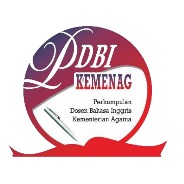Vocational School Students’ Perceptions of Learning Extensive Listening through YouTube Videos
Abstract
This study aims to examine and describe vocational school students' perceptions of learning extensive listening through YouTube videos. The researcher used a mixed methods design to test students' perceptions of learning extensive listening through YouTube videos. Data were analysed quantitatively obtained from questionnaires and qualitatively obtained from the interview method. This study collected data from 36 students from SMKN 12 Malang. The results of the current study indicate students show positive perceptions of learning extensive listening through YouTube videos. A large number of students revealed that YouTube videos can enhance and motivate them to learn to listen extensively. The conclusions of the interviews were strengthened by the results, which that revealed students agreed among the application of YouTube videos for teaching extensive listening. In addition, students believe that YouTube videos are more useful when learning English, especially in teaching extensive listening.
Keywords
Full Text:
PDFReferences
Aktaruzzaman, M., Shamim, M. R., & Clement, C. K. (2011). Trends and Issues to integrate ICT in Teaching Learning for the Future World of Education.
Balbay, S., & Kilis, S. (2017). Students’ Perceptions of the use of a YouTube channel specifically designed for an Academic Speaking Skills Course. Eurasian Journal of Applied Linguistics, 3(2), 235–251. https://doi.org/10.32601/ejal.461003
BENMEDDAH, W. (2017). The Use of ICT in Developing the Speaking Skill in EFL Classes : Case of First Year EFL Students at the University of Tlemcen. 5–73. http://dspace.univ-tlemcen.dz/bitstream/112/11177/1/wafaa-benmeddah.pdf
Bennett, N. J. (2016). Using perceptions as evidence to improve conservation and environmental management. 00(0), 1–11. https://doi.org/10.1111/cobi.12681
Bilyalova, A. (2017). ICT in Teaching a Foreign Language in High School. Procedia - Social and Behavioral Sciences, 237(June 2016), 175–181. https://doi.org/10.1016/j.sbspro.2017.02.060
Brown, R., & Waring, R. (2008). Incidental vocabulary acquisition from reading , reading-while-listening , and listening to stories. 20(2), 136–163.
Brownell, J. (2017). Listening: Attitudes, principles, and skills, sixth edition. In Listening: Attitudes, Principles, and Skills, Sixth Edition. https://doi.org/10.4324/9781315441764
Cahyana, A. A. C. (2020). the Use of Youtube Video in Teaching English for Foreign Language At Vocational High School. Jurnal Pendidikan Bahasa Inggris Indonesia, 8(2), 1–11. https://doi.org/10.23887/jpbi.v8i2.3399
Exley, B. (2005). Learner characteristics of “Asian” EFL students: Exceptions to the “Norm.” Proceedings Pleasure Passion Provocation Joint National Conference AATE & ALEA 2005, 1–16. https://eprints.qut.edu.au/1792/
Faramarzi, S., Tabrizi, H. H., & Chalak, A. (2019). The effect of vodcasting tasks on EFL listening comprehension progress in an online program. International Journal of Instruction, 12(1), 1263–1280. https://doi.org/10.29333/iji.2019.12181a
Kabooha, R., & Elyas, T. (2018). The Effects of YouTube in Multimedia Instruction for Vocabulary Learning: Perceptions of EFL Students and Teachers. English Language Teaching, 11(2), 72. https://doi.org/10.5539/elt.v11n2p72
Lestary, N. L. G. W. (2019). the Use of Songs To Improve Students’ Listening Comprehension Ability. Yavana Bhasha : Journal of English Language Education, 2(2), 34. https://doi.org/10.25078/yb.v2i2.1024
Maritza, A., & Barreto, R. (2018). Motivating English Language Use by using the Benefits of. 16(16), 117–140.
Martínez-Flor, A., & Usó-Juan, E. (2006). Towards acquiring communicative competence through listening. In E. Usó-Juan & A. Martínez-Flor (Eds.), Current Trends in the Development and Teaching of the four Language Skills (pp. 29–46). De Gruyter Mouton. https://doi.org/doi:10.1515/9783110197778.2.29
Maxwell, J. A. (2016). Expanding the History and Range of Mixed Methods Research. Journal of Mixed Methods Research, 10(1), 12–27. https://doi.org/10.1177/1558689815571132
Miranty, D., & Tirtayasa, S. A. (2017). Students ’ Perception of Using Randall ’ s ESL Cyber Listening Lab in the Interpretive Listening Class. 02(02), 209–215.
Pemberton, R. (2004). Teaching and Researching Listening. In System (Vol. 32, Issue 1). https://doi.org/10.1016/j.system.2003.11.004
Polrodi, S., & Pourhosein Gilakjani, A. (2021). the Effect of Audiolingual-Based Versus Communicative Language Teaching-Oriented Techniques on Intermediate Efl Learners’ Listening Comprehension. LLT Journal: A Journal on Language and Language Teaching, 24(2), 493–513. https://doi.org/10.24071/llt.v24i2.3492
Ramadhianti, A., & Somba, S. (2021). Listening Comprehension Difficulties in Indonesian EFL Students. Journal of Learning and Instructional Studies, 1(3), 111–121.
Sanoussi, A., Al Jawad, H., & Mansour, A. A. (2021). International Journal of Linguistics Studies (IJLS) The Significance of Using YouTube as an Academic Tool to Improve Students’ Listening Skill in Libyan Universities. c, 58–70. www.al-kindipublisher.com/index.php/ijls
Sejdiu, S. (2017). Are Listening Skills Best Enhanced Through the Use of Multimedia Technology. 32, 60–72.
Subramaniam, G. K. J., Abdullah, F. P., & Harun, R. N. S. R. (2013). Polytechnic students’ perceptions of youtube usage in the English oral communication classroom. International Journal of Asian Social Science, 3(9), 1962–1966.
Testy, F., Loren, A., Setiawan, B., Sebelas, U., & Surakarta, M. (2017). THE USE OF LEARNING MEDIA ON LISTENING SKILL IN PEMAKAIAN MEDIA PEMBELAJARAN KETERAMPILAN MENYIMAK DALAM PEMBELAJARAN BAHASA INDONESIA BAGI. 11(1), 1–12. https://doi.org/10.24036/ld.v11i1.7625
The Affordances of YouTube for Language Learning and Teaching Jennifer Brook What is YouTube ? (2011). 9, 37–56.
Yee, L. S., & Hu, T. K. (2022). Implementation of YouTube in Teaching Writing: Perception of Malaysian Primary School English Teachers. International Journal of Advanced Research in Education and Society, 4(1), 23–29. https://doi.org/10.55057/ijares.2022.4.1.4
DOI: http://dx.doi.org/10.29240/ef.v7i1.6936
Refbacks
- There are currently no refbacks.
Copyright (c) 2023 Zalfa Nabilah Dzihnie

This work is licensed under a Creative Commons Attribution-NonCommercial-ShareAlike 4.0 International License.
INDEXED BY:
 This work is licensed under a Creative Commons Attribution-NonCommercial-ShareAlike 4.0 International License
This work is licensed under a Creative Commons Attribution-NonCommercial-ShareAlike 4.0 International License
@ ENGLISH FRANCA : Academic Journal of English Language and Education
Jl. Dr. AK Gani No 1 Dusun Curup, Rejang Lebong Regency, Bengkulu Province, Indonesia, 39119.
Dr. Eka Apriani, M.Pd., email: efranca@iaincurup.ac.id, eka.apriani@iaincurup.ac.id.




.png)












